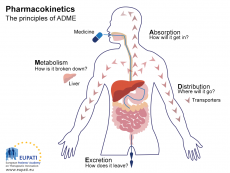

An introduction to Pharmacokinetics
Gastric emptying is modulated by meal size, meal composition (how much fat for example), whether a person has taken a drug or not and one’s physical state. Physical state can be affected by anxiety, when someone is anxious, less blood will flow through the gut and will be subverted to parts of the body that need it more in order to respond to what is causing the stress.
Oral drugs can cause some problems however. For example, aspirin, which is used for pain relief can cause adverse effects. Aspirin blocks prostaglandin production which therefore blocks mucus production. The stomach is surrounded by a layer of mucus. If this mucus layer is decreased, then stomach lumen acid can ‘bite’ into the stomach walls and cause severe pain. If this happens, one may experience indigestion, nausea, vomiting and diarrhoea. 1 in 5 chronic users will experience gastric damage, where the gut bleeds. Additionally, some drugs can inhibit the effects of other drugs. Antibiotics interfere with oral contraceptive cycles (hence why you need to take extra precaution with contraception if you are also taking antibiotics.)
What is first pass metabolism? When drugs enter the body following absorption, they enter the portal system. Drugs with high first pass metabolism are rapidly broken down (by enzymes in bacteria, the liver and gut). So, if this the case, the drug needs to take another route of administration.
Other possible routes to avoid first pass metabolism:
Some drugs can be inhaled as aerosols which are absorbed straight away into the blood. This is how anaesthetics can be administered. Transdermal routes of administration consist of the drug being delivered on the outer surface of the skin and then being absorbed. This can be quite rate limiting however. Nicotine patches are delivered this way. Buccal and sublingual routes require the drug being delivered through on the gums or under the tongue. It then goes straight into the capillaries, this is how GTN (treatment for angina) works. Intranasal routes take up the drug by passive diffusion, GTN can be used this way as well. Rectal routes require being inserted in the correct place. The upper rectum will cause first pass metabolism, but the middle and bottom will not. Subcutaneous routes are the layers under the dermis, taking the drug in by passive diffusion. Insulin is administered this way. Lastly, intramuscular routes are useful in the sense that there is large blood flow, however one must not self-administer as it is highly dangerous. The route of uptake is fast, and long lasting. Perfusion is increased with exercise. Contraceptives and anti-psychotic drugs can be taken this way.
In the plasma, drugs bind to proteins (therefore they are inactive). Active drugs are free in the blood. Albumin (a blood protein) carries weak acidic drugs and glycoproteins carry weak bases. The blood brain barrier contains P-glycoproteins that are drug efflux pumps to try and prevent drugs entering the brain.
Most drugs are metabolised by hepatocytes (liver cells). Drugs are either converted into inactive or active metabolites. Or the drug is excreted unchanged. Metabolites are substances necessary for metabolism.
Image- https://www.eupati.eu/glossary/pharmacokinetics/

0 Comment:
Be the first one to comment on this article.